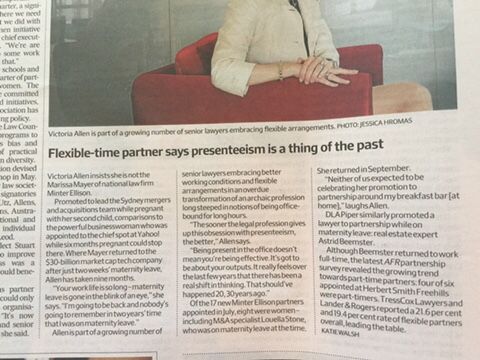My associate Cat Lee and I have worked together since 2003. Initially working in my previous practice with my baby under the desk and her leaving early to pick up hers from day care. When I started this practice, we worked from our own homes and then came together weekly. As we got more work, we moved into my loft bedroom and then to a lounge with an interior designer. We worked about 4 days a week to suit our kids. We shared school holidays one week each and kids always came first. We were set up with computers access from home and have always had a “kids room” with a couch, computer access if sick.
Now there are 8 of us and we are the only full timers + and the other 6 staff are part time including 2 students and 1 grad. I start early 7.30ish and leave at 5.30ish Cat starts at about 9.30ish and leaves around 7. Our senior staff work 3 days a week (which I think is optimum) and students about 2 days and work around uni. Our grad works 2 days as she is a mum of three. Our staff are contracted on a variety of flexible arrangements from permanent part time, to hourly rates to day rates to contracted through their own business.
POSITIVES AS AN EMPLOYER
Helps keep a small practice alive in the current market
Gives an opportunity to have a diversity of skills that may be required at different times.
Both ‘er and ‘ee need to be flexible to work around deadlines, uni and family commitments.
IT is more work to manage the legislation, super, payroll etc.
As an employer I need to manage my client’s expectations. I hear architects say this a lot. However, I think this is the same if the staff member was full time and was working on a number of projects. You are not always available. Cat and I are over every project so this work for us.
Set up senior leadership with opportunity to access files from home.
POSITIVES AS AN EMPLOYEE
Work life balance – whether that be around caring roles with children, parents, pets or other interests like art or music and doing chores.
It also offers flexibility to take family to appointments, take time off if family members are sick and more recently take time off for close family members deaths or need to visit family members overseas.
Flexibility is good for maintaining balance particularly for those employees that have mental health challenges.
There is more opportunity to explore and gain a diversity of skills and project typologies to expand your professional development and expertise
NEGATIVES
Projects take longer and this can affect cash flow and profitability and needs to be managed.
Staff members are not cognisant that employers are running a business and request hours that suit them but not the practice or architectural work eg 9.30 to 2.30 and no school holidays. This just isn’t feasible.
Flexibility doesn’t suit all people and for it to work both parties need to enter into the contract with respect. EG staff taking longer lunches or leaving early or employers expecting staff to take work home or work much longer hours unpaid equivalent to working an extra day.
Communication is a necessity – can lose important info
Lag when they return hence communication.



